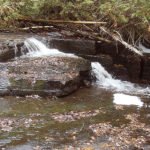Ruffed grouse hunting is part of the Northern Wilds way of life. For many folks, grouse hunting consists of taking a ride along the gravel backroads to see the autumn sights and hopefully happen upon a bird or two to shoot for dinner. Others prefer to hike along old logging roads (not busy designated hiking trails) to get some fresh air and exercise with a grouse dinner as a reward. Then there are a few serious hunters who pursue grouse with a trained dog; either a pointer or flusher.
Using a dog adds immeasurably to the enjoyment of a bird hunting experience, but isn’t necessary to get out in the grouse woods. One of the best things about grouse hunting is that it is accessible to just about anyone, making it an excellent choice for entry level hunters. So, what do you need to know to get started grouse hunting? First, know the rules. If you are new to hunting, begin by taking the Minnesota DNR’s firearms safety course. All persons born after December 31, 1979 are required to possess a firearms safety/hunter education certificate in order to purchase a hunting license to hunt in Minnesota. Regardless your birth date, taking a firearms safety class starts you out with a solid safety foundation. You can learn more about the courses offered on the DNR website.
Another thing you’ll need from the DNR is a small game hunting license. With the license, you’ll receive a booklet with the state’s hunting regulations. While the booklet is formidable, you can find most regulations pertaining to grouse hunting in the Small Game section. Note that you are required to wear a hunter orange hat. Wearing a hunter orange vest or outerwear is advisable so other hunters can easily see you in dense forest cover.
Once you take care of the paperwork listed above, getting prepared for grouse hunting is pretty easy. All you really need is a shotgun, comfortable boots and clothing appropriate for walking in the woods. Some folks may feel more comfortable carrying a GPS or a smartphone app that shows property boundaries and ownership. Considering that most forest land in this region is public and you’ll be walking overgrown logging roads, you can get by without an app if you avoid posted private property.
You can carry just about any shotgun, provided it is loaded with number 8, 7½ or 6 shot. Most likely you’ll be shooting lead loads, because steel loads suitable for grouse can be hard to find. Be sure to spend some practice time shooting at clay pigeons to familiarize yourself with the gun and to develop your shooting skills.
You can hunt grouse at any time of day, but generally the birds are most active in the morning or evening. Since the morning dew is often heavy, you may become soaking wet walking through the foliage on an early hunt. This isn’t a problem in the late afternoon. Speaking of getting wet, waterproof boots are handy if you encounter muddy or swampy areas on your walk.
You can find grouse just about anywhere in our northern forest, although they are scarce in maple forests and red pine plantations. The best places to look for them are in mixed forests of aspen, alder, balsam and spruce. Sometimes they are abundant in stands of young aspen where the tree trunks are the diameter somewhere between your wrist and your calf.
Grouse are attracted to forest openings, such as the one created by a logging road, where they forage on clover, strawberry leaves, various berries and catkins. Like chickens, they also pick grit to aid with digesting their food.
If you are hunting without a dog, you will likely first see a grouse when it is on the ground. Perhaps it will be standing in the logging road or you will hear its distinctive peep-peep-peep call as it tries to avoid you in the underbrush. While you won’t see it depicted in grouse hunting stories, where all birds are shot on the fly, the vast majority of ruffed grouse in the Northern Wilds are shot on the ground. If you have a clear shot and a safe backdrop, take the shot. Aim for the head, which will make a clean kill and leave few pellets in the breast.
Ruffed grouse flush with a thunderous whirr of wings, which can startle an unsuspecting hunter or just about anyone. Grouse have an uncanny ability to twist and turn among the trees, flying through the forest at top speed. Shooting grouse on the wing is challenging even for experienced bird hunters. In September, when the forest is thick with foliage, flying grouse quickly disappear. Your chances of shooting them on the wing improves after the leaves drop in October.
What do you do with a grouse after you kill it? They are easy to clean because their thin skin pulls away from the flesh. The plump breast contains nearly all of the edible meat, although you can get a bite or two off the thighs and legs. Any recipe you use for boneless chicken will work for grouse—and taste better, too.




